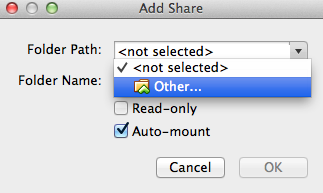This tutorial will explain how to create the "virtual machine" using the "virtual machine player" in order to run the practical exercises.
What is a "virtual machine"? A virtual machine is literally one computer operating system and its applications running on top of another operating system. It is a way of using Linux with MacOSX and Windows for example. But is can also be used to run one version of Linux on another version of Linux. Often called "appliances", virtual machines are useful for providing complete environments for certain applications so that no software needs to be installed on the host computer.
What is a "virtual machine player"? A virtual machine player is an application that is used to run or 'play' the virtual machine. This is typically either 'VirtualBox' or 'VMplayer'. Mac users may be familiar with 'Parallels' which is also a virtual machine (VM) player. The VM player software needs to be installed on the host computer before the virtual machine can be used.
The VirtualBox user documentation page has more complete information about creating and using virtual machines. It includes a FAQ and HowTo articles on various topics.
Before you start
This tutorial assumes you have already downloaded one of the OpenIFS/Metview virtual machines. The virtual machines have been used for the OpenIFS workshops.
If you do not have a virtual machine and would like to try one, please contact openifs-support@ecmwf.int.
Creating the virtual machine
In this tutorial we will assume the use of VirtualBox as the VM player (see: http://www.virtualbox.org/)
- First make sure you have downloaded and installed VirtualBox and it starts correctly.
- Start VirtualBox and click the 'New' button:
- In the window that appears, for Name type 'openifs' (any name is fine), for Type select 'Linux', for Version select 'openSUSE (64bit)'.
- For Memory size, increase it to at least 1200Mb more if you can. Do not move the bar into the red! This will cause your computer to slow down drastically and it may even freeze.
The amount of memory on your computer may be less or more than shown in the figure below. - For Hard drive, select the option 'Use an existing virtual hard drive file'. Then click on the yellow folder icon to locate the virtual machine file. This file will have a name similar to the one shown below and always have the .vmdk extension.
- Then click on the Create button. The newly created virtual machine should now be shown in the left panel.
- Next, click on the Settings icon to change a few of the properties.
- Under the General tab, select Advanced. For Shared Clipboard, enable Bidirectional and likewise for Drag'n'Drop (your system may not support these). When set these will allow cut'n'paste of text between the virtual machine and your computer.
- If (and only if) you have a computer with multiple processors or multiple 'processor cores', you may want to increase the number of processors available to the virtual machine. To do this, in the Settings window, select System, then Processor and adjust the slider. As for memory settings, do not go into the red!
- Enable Shared Folders. This allows both the virtual machine and the real computer to exchange files as both can read and writes files to any directories you specify as a shared folder. n.b. for shared folders to work, the virtual machine may need additional software installed. If it doesn't work, please seek support.
In the Settings window, select Shared Folders and click the blue folder icon with the green cross to create a new one. - In the window that appears, under Folder Path select the folder or directory on the host computer that will act as a shared folder (create it if it doesn't already exist). Then under Folder Name give it a name as it will appear on the virtual machine; shared_folder might be a good choice.
Make sure that Read-only is not selected and Auto-mount is selected. - Close the Setttings box. To start the virtual machine, click the Start green arrow on the main window.
- When the virtual machine has booted, the keyboard layout can be changed by clicking on the small icon labelled 'gb' in the bottom right corner.
The default is set to a UK keyboard.
Adjusting the screen size
The first time the virtual machine (VM) is started, the screen size may be set to 1024x768 pixels.
To change the screen size requires changing the desktop settings in the Linux virtual machine (similar to any Linux desktop)
- Start up the virtual machine and let it start up fully.
- Resize the VM window to the required size.
- In the bottom left corner, find the openSUSE icon and click it.
- Then select 'Applications' and 'Configure Desktop':
- On the window that appears, find the icon labelled 'Display and Monitor' and click it.
- On the display window, click 'Size & Orientation' in the left bar (if not selected).
In the middle panel, find the 'Size' menu: - Select the largest size on this menu. It should match the resized window from step 2.
- Click 'Apply' to set the new resolution:
- Confirm the change and you're done.















